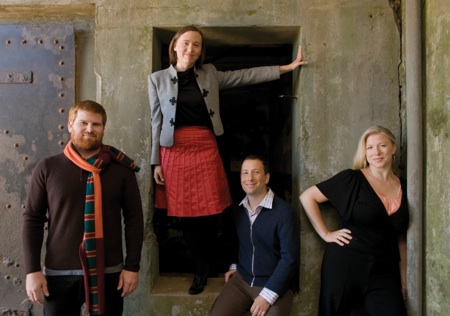Piedmont Center for the Arts—fledgling gem takes flight
The acclaimed Cypress Quartet tested the waters at Piedmont’s brand new Center of the Arts on Friday, September 17. Their sound overflowed the lively central hall, submerging us in sonorous waves.
Like multiple-use art spaces, while enjoying the concert one could also see the current show, a photographic essay of the people and mountains of Peru. Pre-Colombian villages and Incan faces, aged by altitude and unfiltered sun, made the Haydn and Beethoven seem positively modern.
And surprisingly, they were. They opened with a late Haydn quartet, known as “Sunrise” for its transcendent opening and spirited first movement.
First violinist Cecily Ward introduced it. “Haydn wrote over 80 string quartets. In fact he invented the genre—it was he who put those four instruments together that way—and this quartet is thought to be his greatest. A late quartet, it has a quality of intricacy, but the totality of the four is greater than the parts.”
The Cypress Quartet delivered a dense fabric of sound, anchored by cellist Jennifer Kloetzel. And indeed, each strand was cleanly delineated, but the held chords gave us extraordinary blends. Kloetzel’s rich subsonics stretched our hearing to include a visceral scope, while Ward rode the high strings with equal parts care and force. These four have played together for fifteen years, and it was most apparent in their faultless timing. At the end of the first movement, they hesitated as one on the final three chords.
The second movement takes the joyful rising themes and slows them to an elegiac beauty, slow and tender. And brilliant Adagios became the theme of the night.
As a dedication to the Piedmont Center of the Arts they followed Haydn with the slow movement from Samuel Barber’s only string quartet, the famed Adagio. The string orchestra version, Adagio for Strings, was played at Einstein’s funeral and used in the sound track of Oliver Stone’s Vietnam War movie, Platoon. Gentle upward triads paired the instruments, with expressive violist Ethan Filner soaring through the center of the sound.
Beethoven wrote his Quartet in A-minor, op. 132 in 1825, during an almost-fatal illness and unexpected recovery, circumstances that brought edge even to his mature genius. After breaking off from composing, he resumed months later with the third movement, Molto Adagio, a slow song of thanks. In the folio it is inscribed “A Convalescent’s Holy Song of Thanksgiving to the Divinity, in the Lydian Mode.” His sublime third movement opens and closes with tentative rising fifths, followed by harmonic progressions that have an inner certainty. The center of the movement sounds like a Bach chaconne, Beethoven’s fervent thanks to the master of fugue, and one who infused joy in its mathematical purity. In Beethoven’s hands it is a joy so sharp it can cut.
The Cypress quartet gave it grace and solemnity, with occasional viola double stops in the denser harmonies. At one point I realized that Ward was playing with her eyes shut, so I also shut mine and sank into their lovely sound.
 They came back after several ovations for an encore, the finale from Dvořák’s String Quartet No. 12, the “American” quartet. Soaring violin lines, “train track” underpinnings and the simplicity of pentatonic scales added a folky character to Dvořák’s merging of careful orchestration and heartfelt line—a perfect Bavarian hoe-down! This was an upbeat ending to an excellent concert, and one hopes this quartet will return often.
They came back after several ovations for an encore, the finale from Dvořák’s String Quartet No. 12, the “American” quartet. Soaring violin lines, “train track” underpinnings and the simplicity of pentatonic scales added a folky character to Dvořák’s merging of careful orchestration and heartfelt line—a perfect Bavarian hoe-down! This was an upbeat ending to an excellent concert, and one hopes this quartet will return often.
—Adam Broner
Photo courtesy of the Cypress Quartet website, from left: viola Ethan Filner, violinists Cecily Ward and Tom Stone, and cellist Jennifer Kloetzel.
